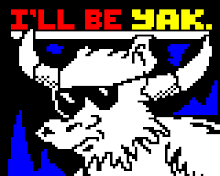 Art Typing, Nathan Krevolin, 1962 - excerpts
Art Typing, Nathan Krevolin, 1962 - excerptshttp://www.textfiles.com/art/texthistory.txt
http://hem1.passagen.se/haakshem/asciians.html
http://www.doheth.co.uk/funny/google.php
The text file in the first link, created in 1999, briefly examines the history of imagery as text, citing the hieroglyphics used by Ancient Egyptians to communicate. It makes reference to a 1950's artwork by Korean Gwang Hyuk Lee made up of text from the "Book of John". An image of this is shown right.
In the early 20th Century, "calligrams", that is, utiilising shaped text in visual word poems, became popular. Most of the ASCII art is from Krevolin's book and there is mention of teletyping, a forerunner to the ASCII format. EBCDIC was another competitor for the standard encoding on computers, but in the end, ASCII, a code by ANSI (American National Standards Institute) won out. ANSI code is essentially ASCII.
 Early ASCII art was spread via e-mail, bulletin boards and other online activities, such as in MUDs (Multi User Dungeons). This page from the earlier days of the Internet explains ASCII art briefly and a number of 'artpacks' to download. The site's design is also typical of the early days of the Internet, being rather primitive with jagged, brightly coloured graphics.
Early ASCII art was spread via e-mail, bulletin boards and other online activities, such as in MUDs (Multi User Dungeons). This page from the earlier days of the Internet explains ASCII art briefly and a number of 'artpacks' to download. The site's design is also typical of the early days of the Internet, being rather primitive with jagged, brightly coloured graphics."Microsoft declared ASCII art "dead" in June of 1998. Why? I'm not sure. But I would guess that Microsoft is encouraging people to use GIF and JPG graphics -- of course, with their software."
 Whilst there is no doubt ASCII and ANSI art is on the decline somewhat in comparison to the early Internet, I would tend to disagree with this - it seems to be sensationalism on Bill Gates' part. Maybe because of its synonymous links with the Internet as well as its existence as a creative and distinctive artform, the medium survives today.
Whilst there is no doubt ASCII and ANSI art is on the decline somewhat in comparison to the early Internet, I would tend to disagree with this - it seems to be sensationalism on Bill Gates' part. Maybe because of its synonymous links with the Internet as well as its existence as a creative and distinctive artform, the medium survives today.

0 comments:
Post a Comment